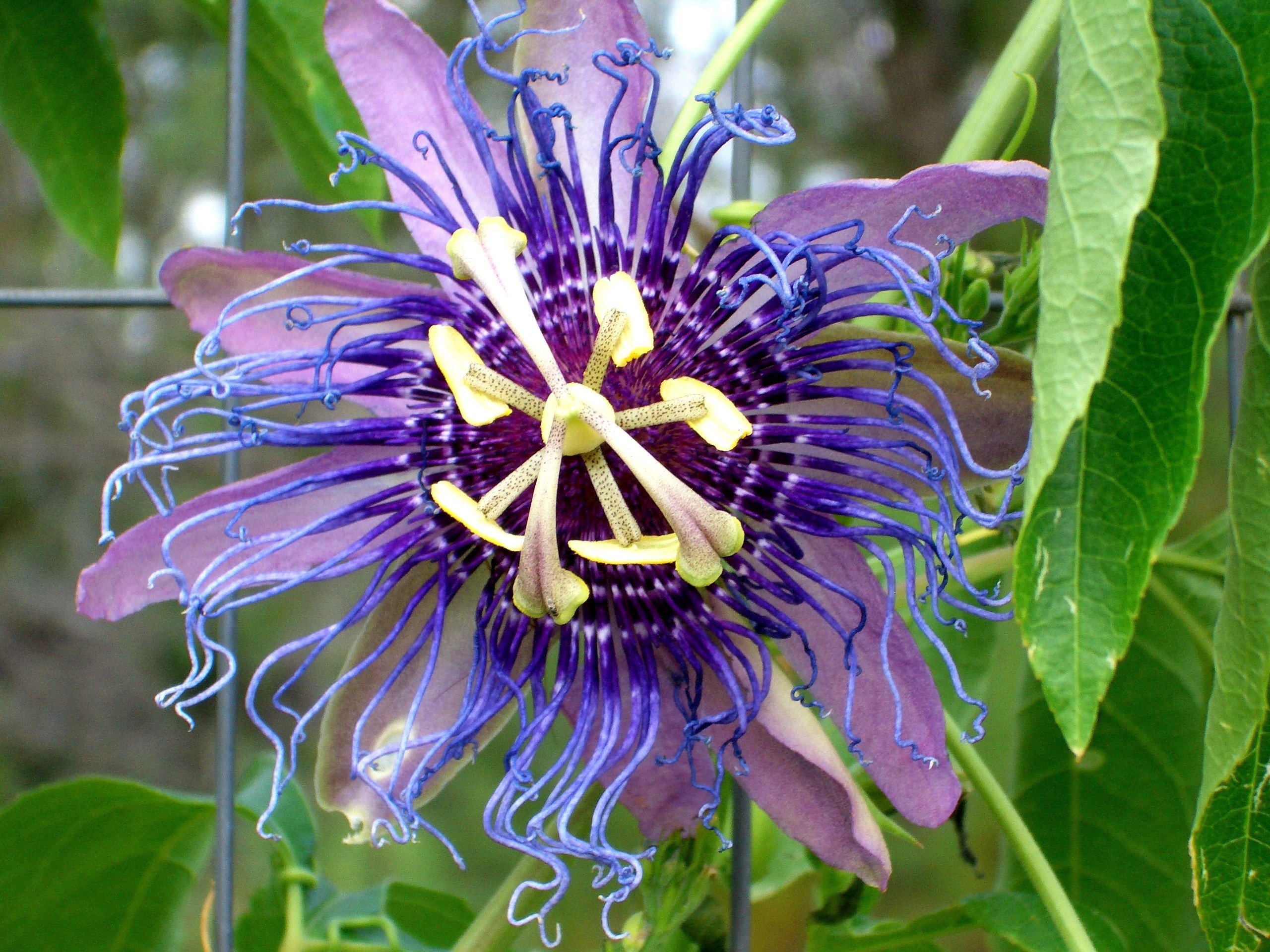
by Carrie Stevenson | Aug 11, 2017
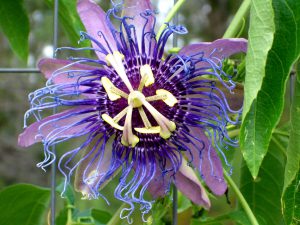
The passionflower vine is beautiful and attracts butterflies, but can also be used for food and sedation drugs. Photo credit: Dorothy Birch
Ethnobotany lies at the intersection of culture, medicine, and mythology. The “witch doctors” and voodoo practitioners, the followers of the Afro-Cuban religion of Santeria, and the wise elders of ancient Chinese civilizations are all ethnobotanists. So, too, are the modern day field biologists who discover and develop medicinal plants into an estimated half of our pharmaceutical drugs. Simply put, ethnobotany is the study of how people and cultures (ethno) interact with plants (botany).
For tens of thousands of years, humans have been learning about plants’ chemical, nutritious, and even poisonous properties. Plants evolve these properties to defend themselves against pathogens, fungi, animals and other plants. Other properties, like color, scent, or sugar content may attract beneficial species. Humans most likely started paying attention to plant characteristics to decide whether to eat them. From there, one can imagine people started using plants to build structures or use fiber for ropes, baskets, and clothing.
My first experience with the idea of ethnobotany was as a college student on a study tour of Belize. A professional ethnobotanist took us on a tour of the Maya Rainforest Medicine Trail, pointing out dozens of native trees, shrubs, and grasses used for medicinal and cultural purposes by local tribes. From birth control and pain relief to chewing gum and pesticides, the forest provided nearly everything Central American civilizations needed to survive for thousands of years and into the present. The tour captured my imagination as I considered the possibilities yet undiscovered in the deep rainforests worldwide.
Of course, there is no need to travel out of the country, or even the state, to learn about useful native plants. One of my favorite publications put out by UF IFAS Extension specialists is “50 Common Native Plants Important in Florida’s Ethnobotanical History.” Another fascinating source of information about historic, cultural, and even murderous uses of plants is Amy Stewart’s Wicked Plants: The Weed That Killed Lincoln’s Mother and Other Botanical Atrocities. Plants with interesting historical uses make for great stories along a trail, and help create a connection between the casual observer and the natural world around them.
A handful of interesting native plants with significant medicinal properties include the cancer-fighting plants saw palmetto (Serenoa repens) and mayapple (Podophyllum peltatum). Saw palmetto berries are used for prostate cancer treatment, while the $350+ million annual Florida mayapple harvest helps produce chemotherapy drugs for several types of cancer. The carnivorous bog plant, pink sundew (Drosera capaillaris) uses enzymes to break down insect protein, and Native American tribes used the plant for bacterial and fungal skin disorders.
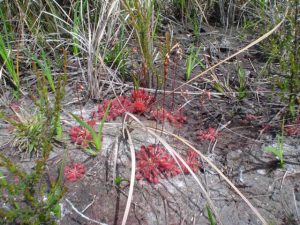
Sundews, tiny carnivorous plants found in pitcher plant bogs, use an enzyme to dissolve insect proteins. Native Americans recognized this property and used the plant for skin maladies. Photo credit: Carrie Stevenson, UF IFAS Extension
Many plants had (and still have) multiple uses. Yaupon holly (Ilex vomitoria) leaves brewed as a highly caffeinated tea were used ceremonially and before warfare by many southeastern American Indian tribes, and then later by early American settlers when tea was difficult to import. Holly branches were used for arrows, and the bark for warding off nightmares. The purple passionflower, or maypop (Passiflora incarnata) vine attracts butterflies and produces a pulp used for syrups, jams, and drinks. Passionflower extract has also been developed into dozens of drugs and supplements for sedation.
Early civilizations living closer to the land knew many secrets that modern medicine has yet to unlock. Thanks to the ethnobotanists, the field and forest will continue to heal and provide for us for many generations yet to come.
CAUTION: Many of the plants listed or referenced can have hazardous or poisonous properties without appropriate preparation or dosage. Allergic reactions and prescribed drug interactions may occur, and many unproven rumors exist about medicinal uses of plants. Always consult a physician or health professional before trying supplements.
by Ray Bodrey | Aug 1, 2017
Many folks may not realize it at first, but everyone is using pesticides. Have you recently used a mold or mildew removal cleaner in your bathroom? Do you apply flea & tick powder to your pet? It is a misconception that only farmers, ranchers and lawn and garden enthusiasts are pesticide users. So, let’s all keep safety in mind, as any of these household and outdoor chemicals can be dangerous.
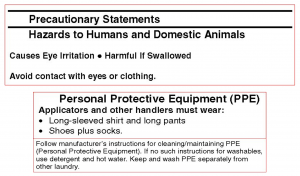
Example of Precautionary Statement and Personal Protective Equipment Instruction. Credit: UF/IFAS Extension
Pesticides include a wide range of products that either kill or repel pests. These pests can be insects, nuisance animals, weeds, plant pathogens, molds and other undesirables. Are pesticides necessary? Maybe not. Pesticides should be considered as a last resort. Using an integrated pest management (IPM) approach is an environmentally safe, and often, economical way to reduce pests. Usually, there are four steps involved in IPM, starting with the practice with the least environmental impact, until a solution to the pest problem has been found. For example, say that you are having issues with aphids in your garden. The IPM approach may begin with cultural measures (ex. avoiding high nitrogen fertilizer as it promotes lush growth that creates a favorable environment for aphids). This may be followed by mechanical measures (ex. use of insect netting) and if problem still exists, biological measures (ex. release of parasitic wasps). As stated earlier, the last resort would be chemical measures (ex. applying pesticide). There are varying IPM strategies for different pests. Please visit the UF/IFAS IPM website for more information: http://ipm.ifas.ufl.edu/
When pesticide usage is necessary, it’s important to select the right chemical(s). Once the pest has been identified, check pesticide labels under the section “pests controlled”. Never assume a pesticide will control a pest not listed under this section. Often, there are numerous products that list a common pest. Always consider five factors when determining the right pesticide: environmental friendliness, effects on beneficial organisms, ease of use, available application equipment and cost.
Once a pesticide has been chosen, be sure to follow the directions. It is critical to mix a concentrated pesticide accurately, therefore follow the product label. Diluting concentrated pesticides by mixing with water is necessary to achieve the correct concentration. Increasing the concentration is dangerous and will have a negative response. The response can be environmental harm, damage to desirable plants and beneficial organisms and above all, it’s illegal to apply rates greater than the specified label.
Remember, pesticide exposure can be life threating under certain circumstances. Pesticides can enter the body in several ways. The most common entries are mouth, inhalation, eyes or skin. Always wear personal protective equipment (PPE) when mixing and applying pesticides. Precautionary statements for humans and domesticated animals will be supplied on the product label. Examples of safety information are: causes eye irritation, harmful if swallowed or avoid contact with eyes or clothing. Dress accordingly based on the safety information supplied by the product label. Some types of PPE are long rubber gloves, goggles, respirators, waterproof apparel and rubber boots.
All pesticides should be stored out of the reach of children. Pesticides stored in any container not deemed pesticide compatible (ex. canning jars and food or soft drink containers) is illegal. For more information on pesticide safety and best management practices, contact your local county extension office.
Supporting information for this article can be found in the UF/IFAS EDIS publication: “Homeowner’s Guide to Pesticide Safety” by Frederick M. Fishel: http://edis.ifas.ufl.edu/pdffiles/PI/PI05100.pdf
UF/IFAS Extension is an Equal Opportunity Institution.
by Matt Lollar | Aug 1, 2017
The Jackson County Master Gardeners will host a “Gardening in Containers” Workshop on Saturday, August 19 from 9 AM to 2 PM at the Jackson County Extension Office, 2741 Penn Ave., Marianna, FL. The workshop will give you simple tips on growing vegetables, herbs, and flowers in containers. Bring your own unique container. Plant material and soil will be provided. The workshop is $25 and includes a home cooked lunch. Please see the flyer below for more details and call 850-482-9620 to pre-register.
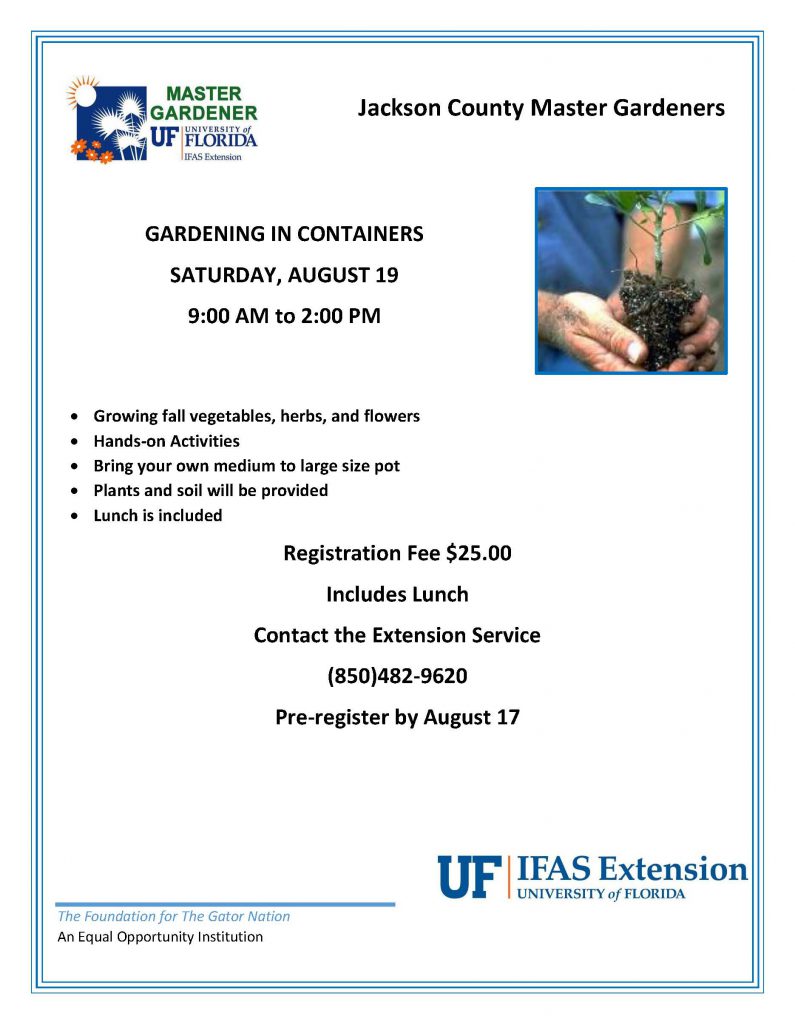
by Mark Tancig | Aug 1, 2017
Florida’s panhandle has received quite a bit of rain this summer. In the last three months, depending on the location, approximately 15 to 35 inches of rain have come down, with the western panhandle on the higher end of that range. In addition to the rain, we all know how hot it has been with heat index values in the triple digits. And who can forget the humidity?! Well, these weather conditions are just the right environmental factors for many types of fungi, some harmful to landscape plants, most not.
In the classification of living things, fungi are divided into their own Kingdom, separate from plants, animals, and bacteria. They are actually more closely related to animals than plants. They play an important role on the Earth by recycling nutrients through the breakdown of dead or dying organisms. Many are consumed as food by humans, others provide medicines, such as penicillin, while some (yeasts) provide what’s needed for bread and beer. However, there are fungi that also give gardeners and homeowners headaches. Plant diseases caused by various fungi go by the names rusts, smuts, or a variety of leaf, root, and stem rots. Fungal pathogens gardeners may be experiencing during this weather include:
- Gray leaf spot – This fungus can often show up in St. Augustine grass lawns. Signs of this fungus include gray spots on the leaf (very descriptive name!). This disease can cause thin areas of lawn and slow growth of the grass.
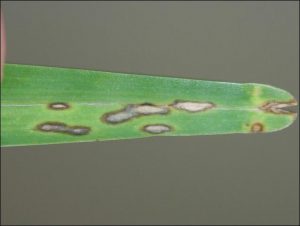
Gray leaf spot on St. Augustine grass. Credit: Phil Harmon/UF/IFAS.
- Take-all root rot – This fungus can attack all our warm-season turfgrasses, and may start as yellow leaf blades and develop into small to large areas of thin grass or bare patches. The roots and stolons of affected grasses will be short and black.
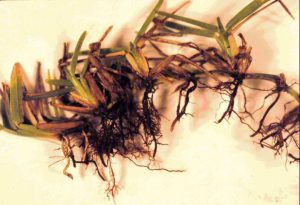
Signs of take all root rot. Credit: UF/IFAS.
Powdery mildew – This fungus can be found on many plants, from roses to cucumbers. It looks like white powder on the leaves and can lead to plant decline.
- Armillaria root rot – This fungus can infect a variety of landscape plants, including oaks, hickories, viburnums, and azaleas. Symptoms can include yellowing of leaves and branch dieback, usually in adjacent plants. Old hardwood stumps can harbor this fungus and lead to the infection of nearby ornamentals.
Because fungi are naturally abundant in the environment, the use of fungicides can temporarily suppress, but not eliminate, most fungal diseases. Therefore, fungicides are best used during favorable conditions for the particular pathogen, as a preventative tool.
Proper management practices – mowing height, fertilization, irrigation, etc. – that reduce plant stress go a long way in preventing fungal diseases. Remember that even the use of broadleaf specific herbicides can stress a lawn and exacerbate disease problems if done incorrectly. Since rain has been abundant, irrigation schedules should be adjusted to reduce leaf and soil moisture. Minimizing injury to the leaves, stems, and roots prevents stress and potential entry points for fungi on the move.
If you think your landscape plants are suffering from a fungal disease, contact your local Extension Office and/or visit the University of Florida’s EDIS website at http://edis.ifas.ufl.edu for more information.
by Matt Lollar | Aug 1, 2017
I encountered pickleweed (Salicornia sp.) on a recent trip to Utah. I first noticed the plant growing in the bank of a pond at a salt factory. A sample was pulled for further investigation and it was determined to be some type of pickleweed. Pickleweed also happens to be a common name for a plant that grows here in Florida. The scientific name of the pickleweed found in Florida is Batis maritima. This article will focus on the pickleweed found in Utah.
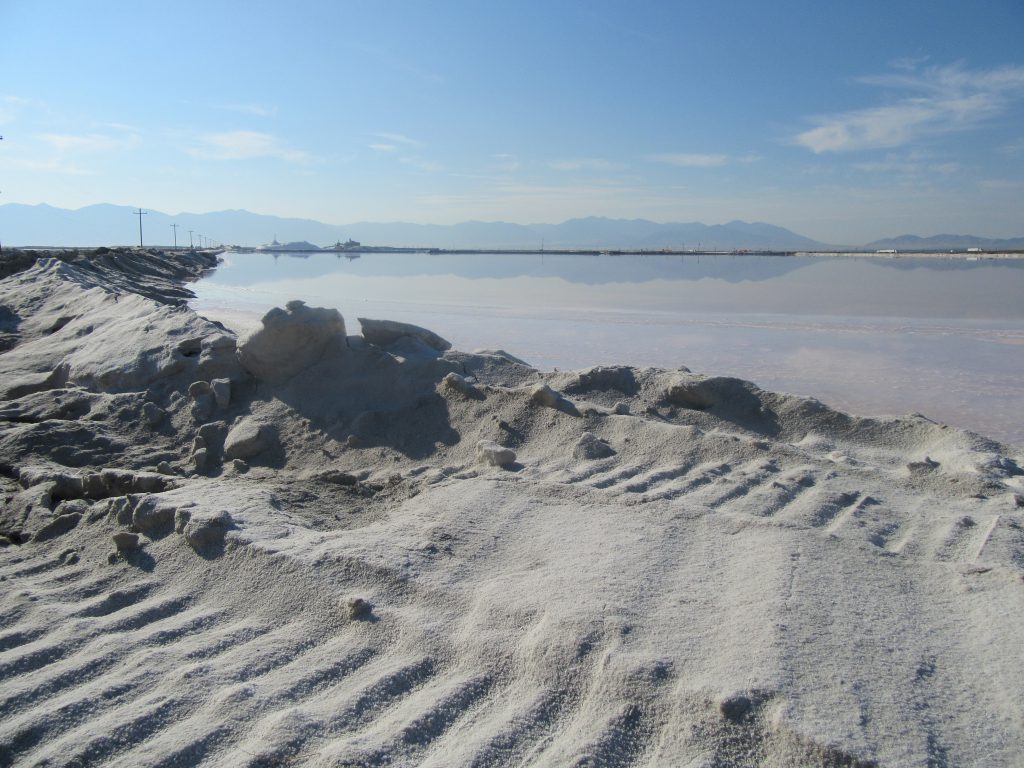
A salt factory in Utah. Photo Credit: University of Florida/IFAS Extension.
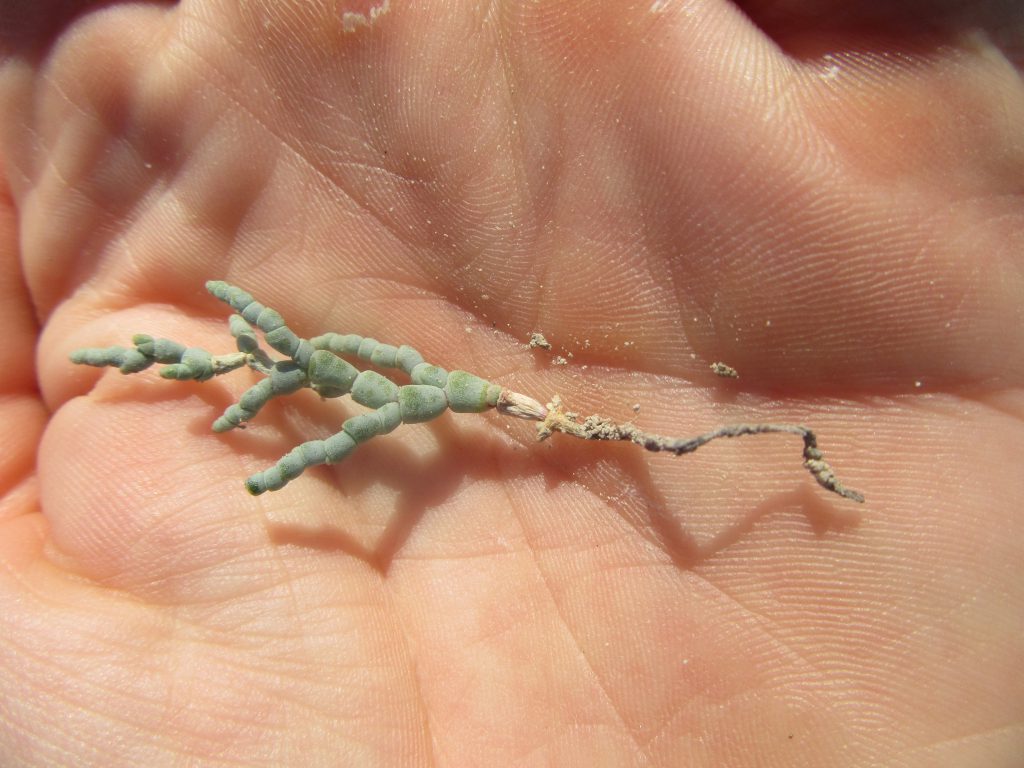
A pickleweed pulled out of a pile of salt. Photo Credit: University of Florida/IFAS Extension.
As you might have guessed, pickleweed is a salt loving (halophylic) plant. It is a member of the plant family Amaranthaceae (previously Chenopodiaceae), which also includes Russian thistle (Salsola iberica) a.k.a. tumbleweed. You won’t be happy to know that Russian thistle has found its way to our beautiful Florida beaches and is spreading. At first look, pickleweed seems to have no leaves, but its central stem is surrounded by succulent, salt storing leaf tissue. It is often spoken of as the “cactus” of the Great Salt Lake since it has no visible leaves and only a smooth green stem.
Pickleweed can be found growing in both coastal and interior portions of the United States. The variety growing around the Great Salt Lake is different from the coastal varieties due to its adaptation to this extremely salty environment. The Great Salt Lake has a salt content of about 30% whereas the Gulf of Mexico has a salt content of around 3%.
Pickleweed can also be found growing in the western landscape adjacent to the Great Salt Lake. These areas contain an interesting type of soil made up of ooids. Ooids are brine shrimp feces coated with layers of aragonite (a form of calcium carbonate CaCO3). Ooids can also be found on the east coast of Florida.
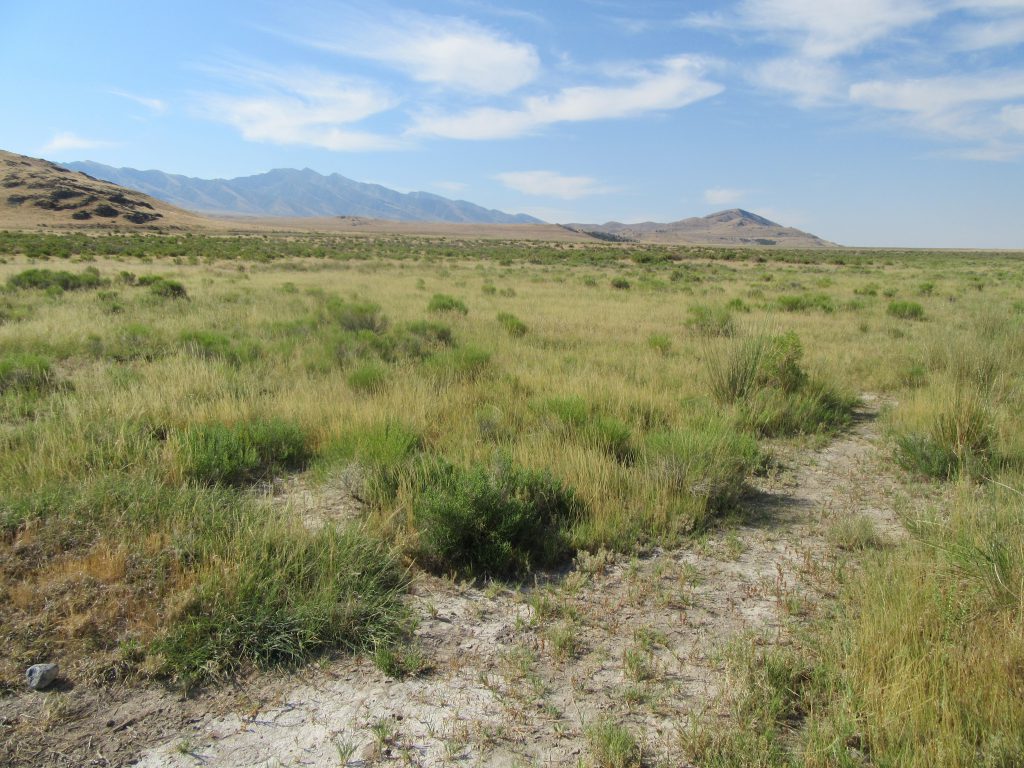
Pickleweed and other plant species growing in the Utah landscape near Timpie Springs. Photo Credit: University of Florida/IFAS Extension.
Although you probably won’t find pickleweed (Salicornia sp.) growing in a typical Florida Panhandle landscape, you might want to give it a try in your container garden or kitchen window. As you can see in the pictures, this plant likes to be neglected. It is difficult to grow at home. It needs a good amount of nitrogen and water. And it may benefit from periodic additions of table salt (sodium chloride). It needs to be in an area that receives 6 to 8 hours of sunlight per day. Seed and cuttings will be hard to come by. You will most likely have to take a trip to Utah to find a source.
Interestingly enough, some cultures use this plant as a vegetable/herb. You will need to conduct some more research if you wish to cook with pickleweed and remember to lay off the salt!










